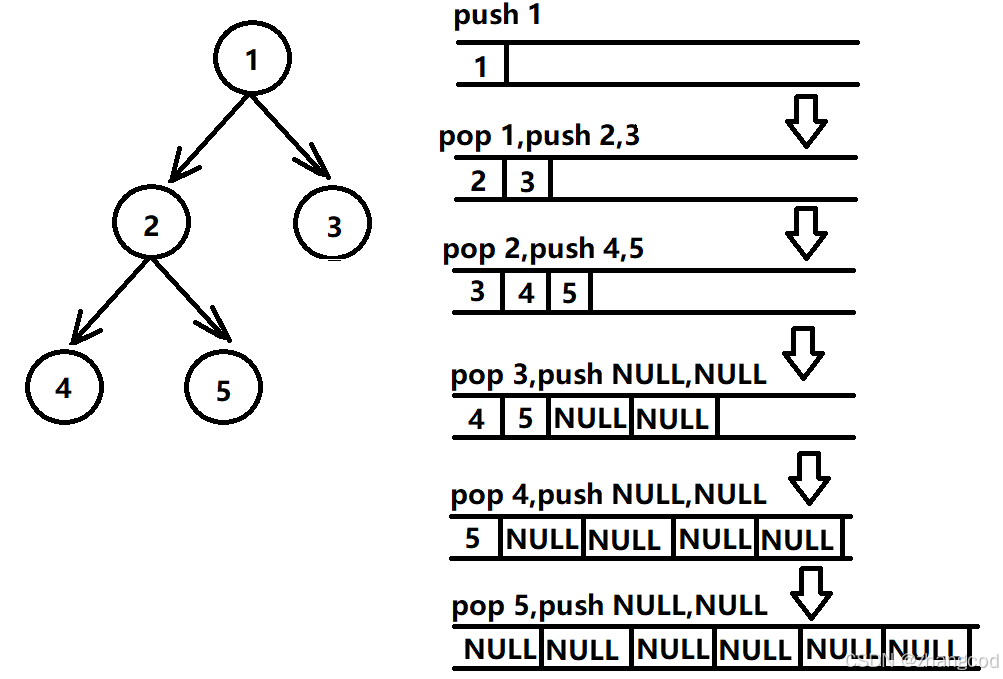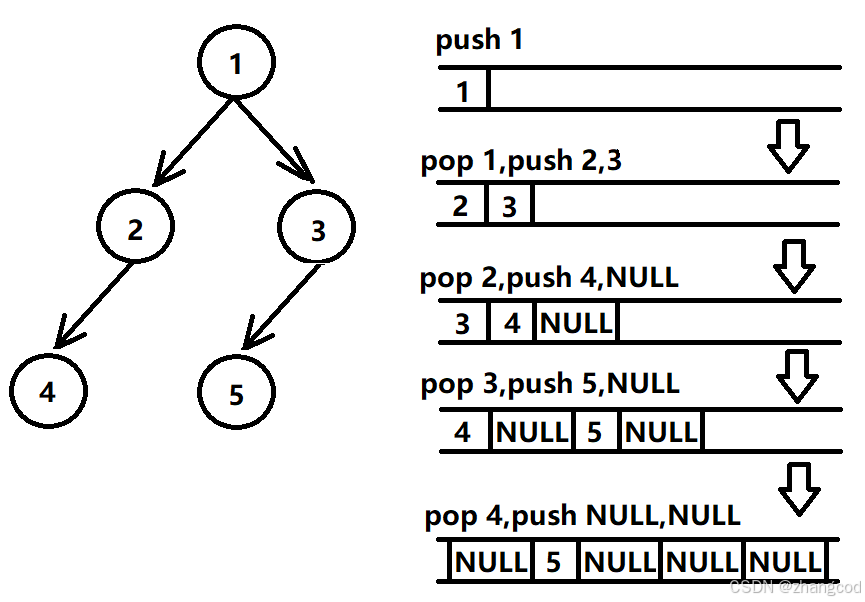目录
1.知识回顾
完全二叉树和非完全二叉树参见100.【C语言】数据结构之二叉树的基本知识文章
2.分析
使用层序遍历(队列),核心思想参见109.【C语言】数据结构之二叉树层序遍历文章
这里对比完全二叉树和非完全二叉树在层序遍历中的区别
注意:和以往的层序遍历有所不同,空节点也要push(push它的地址NULL)
完全二叉树队列示意图

非完全二叉树队列示意图

区别
当两个队列的队头为NULL时,观察两个队列之间的区别
完全二叉树:元素全为空
非完全二叉树:有非空元素
可以此来判断是否为完全二叉树
3.代码
执行过程
初始化队列-->非空树,将根节点的地址入队-->层序遍历+出栈+入栈-->对队头的值判断(为NULL则一直出队,遇到非空则销毁队列+返回false)
层序遍历+出栈+入栈
根节点出栈,出栈前需要保留根节点的地址,以便于左右节点入栈(front->left和front->right,不是root->left和root->right)
大概的结构
cppBTNode* front = QueueFront(&q); QueuePop(&q); QueuePush(&q,front->left); QueuePush(&q,front->right);疑问1:不是对根节点的左右节点入栈吗?为什么不写成root->left和root->right呢?
root一直是整个二叉树根节点的地址,导致root->left和root->right的值一直没有变化,导致死循环
如果写成front->left和front->right,每次循环时,front的值会改变(依据队头的值进行调整)
cswhile (!QueueEmpty(&q)) { BTNode* front = QueueFront(&q); QueuePop(&q); if (front == NULL) break; QueuePush(&q,front->left); QueuePush(&q,front->right); }最终当队头为NULL时,退出循环
疑问2:第一个while的部分能写成下面这两种吗?
cppBTNode* front = QueueFront(&q); while (1) { front = QueueFront(&q); QueuePop(&q); if (front == NULL) { break; } QueuePush(&q, front->left); QueuePush(&q, front->right); }
cppwhile (QueueFront(&q)) { BTNode* front = QueueFront(&q); QueuePop(&q); if (front == NULL) { break; } QueuePush(&q, front->left); QueuePush(&q, front->right); }两种写法均可以,while循环退出的唯一出口在if (front==NULL),由于NULL也入队,因此不存在队列为空的情况
完整代码
cpp
bool TreeComplete(BTNode* root)
{
Queue q;
QueueInit(&q);
if (root)
QueuePush(&q, root);
while (!QueueEmpty(&q))
{
BTNode* front = QueueFront(&q);
QueuePop(&q);
if (front == NULL)
break;
QueuePush(&q,front->left);
QueuePush(&q,front->right);
}
while (!QueueEmpty(&q))
{
BTNode* front = QueueFront(&q);
QueuePop(&q);
if (front)
{
QueueDestroy(&q);
return false;
}
}
QueueDestroy(&q);
return true;
}注意返回前养成好习惯,需要销毁队列
main.c写入
cpp
int main()
{
BTNode* root = CreateTree();
printf("TreeComplete:%d", TreeComplete(root));
return 0;
}备注:创建的二叉树的结构为

运行结果
